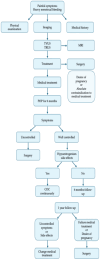Endometriosis and Adenomyosis: From Pathogenesis to Follow-Up
- PMID: 40699697
- PMCID: PMC12110143
- DOI: 10.3390/cimb47050298
Endometriosis and Adenomyosis: From Pathogenesis to Follow-Up
Abstract
Endometriosis and adenomyosis are chronic, hormone-dependent disorders. Estrogens, in particular, play a pivotal role in the pathophysiology of these conditions. Understanding the disease mechanisms, including local hyperestrogenism and reduced progesterone sensitivity, is crucial for effective management. Early diagnosis is essential for appropriate therapeutic intervention, with medical hormonal treatment being the first-line approach. It is important to monitor patients over time and tailor hormone therapy to individual needs in order to optimize treatment adherence. Medical therapy not only enhances patients' quality of life but also appears to slow disease progression in terms of both extent and severity. This narrative review aims to explore all aspects of endometriosis and adenomyosis, from pathogenesis to clinical symptoms, with particular emphasis on the role of hormones and the use of medical therapies.
Keywords: adenomyosis; endometriosis; management; pathogenesis; symptoms.
Conflict of interest statement
The authors declare no conflicts of interest.
Figures
References
-
- Martire F.G., Giorgi M., D’abate C., Colombi I., Ginetti A., Cannoni A., Fedele F., Exacoustos C., Centini G., Zupi E., et al. Deep Infiltrating Endometriosis in Adolescence: Early Diagnosis and Possible Prevention of Disease Progression. J. Clin. Med. 2024;13:550. doi: 10.3390/jcm13020550. - DOI - PMC - PubMed
Publication types
LinkOut - more resources
Full Text Sources



